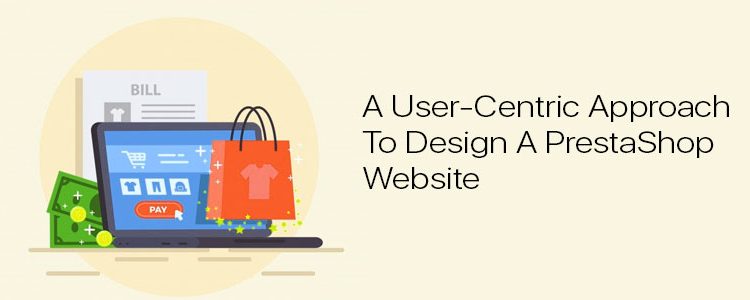To build an interactive & powerful eCommerce website, PrestaShop surely is a great option for all small businesses and biggies. The major benefit of PrestaShop website development is that the store admin can simply manage the entire website with a few tweaks which ultimately gives tremendous results in a matter of reach and sales.
By now, almost every eCommerce business is aware that they must serve their customers in a more personalized manner than ever. This has led e-businesses to take extensive measures & build loyalty with their audiences. Such a business pattern has improved the brand reputation of those companies & witnessing that more & more businesses have started to implement such designing in the store.
But in order to design a PrestaShop website with a customer point-of-view on the top, one must re-consider multiple factors than just conventionally designing an eCommerce website. This article aims to unfold various such parameters that help in designing a PrestaShop web-store with a great focus on improving user experience & satisfaction. Check the points discussed below to know further in detail:
#1. List Down Your Needs:
Determine whether you would be requiring a multi-vendor marketplace or just a single store. Similarly, lay out all your plans so that the concerned team can work on the best possible design for your PrestaShop website.
If you already have a PrestaShop website & you only need to redesign it, instead of building a new site, be clear on the checks and trends. After that, get along with your further move.
#2. Responsive Design:
Keep your PrestaShop website as an omnichannel. Because a lot of us access the internet via smartphone on a daily basis, the design of the store must be compatible with mobile devices as well aka responsive design.
In fact, eCommerce businesses are going a level up by not just having a responsive design but also having AMP (Accelerated Mobile Pages) or PWA (Progressive Web Apps) or even their own PrestaShop Mobile App. All these contribute to acquire & serve a variety of customers on all possible devices and browsers.
By default, PrestaShop is responsive. But if any custom re-designing is coded, then that must be manually made responsive as well to make it appear beautifully on the mobile devices.
#3. Include CTA’s:
Call-To-Action elements are really important as they are meant to attract visitors so that your business can acquire more leads. CTA is usually kept precise with a straightforward yet catchy message. It should urge the site visitors to interact & take action.
The most common one is a CTA Button for newsletter sign-up. Based on your purpose use any relevant CTA s on the webpage but make sure not to overdo it.
#4. Showcase Customer Reviews:
On the website product page, have a design that allows users to write reviews of the products purchased by them. Having such testimony influences others to purchase the products based on their reviews. It has also been found e-shoppers find it good to have genuine reviews on products. This ensures unbiased information on products and helps newbies in making the decision.
As per a survey, 84% of people trust product reviews as much as they trust their friends’ recommendations. So, it’s a trendy & must-have feature to offer honest reviews for the products.
#5. Seamless Navigation & Accessibility:
On any eCommerce website, it’s not ideal to have the products listed without proper categorization. Apart from just categorizing the products, each category/ sub-category must be arranged on the navigation-bar/ toggle- menu in a way that the customers don’t need to make more than 4 to 5 clicks to reach their choice. Also, have all other necessary links in the navigation menu.
Set the category URLs to be SEO friendly & have relevant thumb-nail images with alt tags on images’ source code. This further enhances your on-site SEO & makes your category image discoverable & reachable on search results.
#6. Product Page Design:
Depending on the product you are selling, add necessary fields like SKU, dimensions /weight, expiry date, stock availability, minimum quantity per order, shipping charges & taxes, deliverability in specific areas (Pincode), etc. Have the option to add a product to wishlist. Some eCommerce websites also allow users to create multiple wishlist folders which they can also share with their respective friends. This can also encourage the new visitors to set up a new account & contribute to increasing conversions on your eCommerce site.
Add the Social Sharing quick links for popular platforms like Facebook, WhatsApp, Pinterest, Instagram, custom URL, etc. Apart from product images, it’s also a trend to add a video about the product. It helps the customers to get a better view of various details about the product. This further helps to boost sales for that particular product. For instance, the assembly video of a DIY Wardrobe (like IKEA).
#7. Add A Chatbot:
Chatbots have the power to be statically/ dynamically serve the customers 24/7. Also, about 50% of the netizens prefer to initially connect with a company via their chatbots. So, incorporate a chatbot and let users share their queries with you. Static chatbots are quite affordable & can even be automated to some extent. Chatbots can also be integrated with AI technologies to offer more dynamic & human-like support. Choose the one according to your business requirements.
#8. Simplified Checkout Procedure:
A lengthy & complicated checkout process can churn the online shoppers leading to reduced satisfaction and retention. To avoid such downfalls, have quick checkout procedures by designing a One-Page Checkout on the website. Optimize it to have some pre-filled entries like previous addresses, phone no’s, etc. Nowadays, majority websites even have the previously used payment options saved for faster checkouts.
Guest checkouts are also getting trendy among eCommerce businesses. It is helpful for the new visitors who don’t want to go through lengthy signup processes & increase efforts in checkout.
#9. Secure Payment Methods:
Offer all reliable payment options on the store according to the audiences you are serving. Set up your payment gateways along with all required security factors. Keep the process simpler so that users don’t back out from checkouts & payments.
#10. Strategies For User Retention:
User retention plays a vital role in improving sales of the PrestaShop website as returning users come with the best chance for more purchases. Keep your eCommerce store design to be enough encouragement for users to keep coming back in the future for shopping. Relevant CTA’s can be used to achieve the same. Attractive and catchy upcoming sale banners with correct display of vouchers, coupons, referral programs or loyalty programs usually helps is user retention.
Conclusion:
All the above factors help in designing an eCommerce website that makes an ecosystem of personalized services for your customers. It’s all about giving great focus on how to serve your customers in a better way.
If you are willing to give your best in designing such a website, we suggest you connect with KnowBand Plugins or drop us an email at support@knowband.com. After all, in such a competitive retail environment, there mustn’t be any factors to slow down your business.








